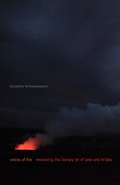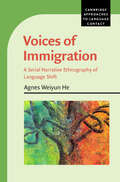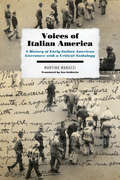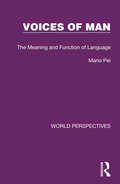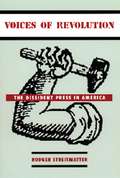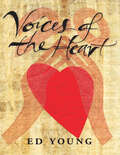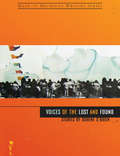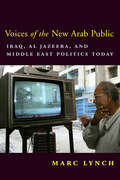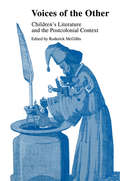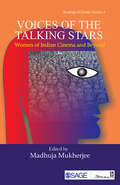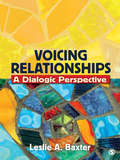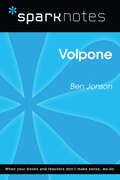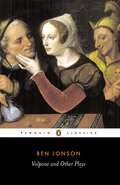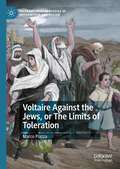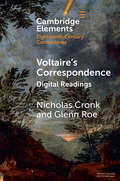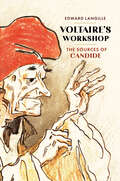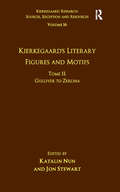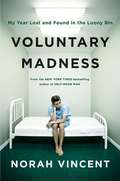- Table View
- List View
Voices of East Asia: Essential Readings from Antiquity to the Present
by Margaret Childs Nancy HopeVoices of East Asia provides significant yet accessible readings in translation chosen to stimulate interest in the long and rich cultural history of East Asia, the countries of China, Japan, and Korea. The readings range from ancient to modern, elite to popular, and include poetry, stories, essays, and drama. Each section begins with a broad but brief overview of that country’s political and cultural history. Each reading is preceded by a concise explanation of its literary and cultural context. As expertise in East Asian studies has exploded in the West in recent decades, a novice could be overwhelmed by all the materials available now. In this volume, however, the reader will find a manageable set of texts that may be read on their own, as part of a world literature course, or as supplementary readings for an East Asian history class. As economic and political news from East Asia sweeps across the world, this anthology aims to provide a taste of the enduring traditions upon which contemporary East Asia is built, a glimpse into the hopes and fears, love and sorrow in the hearts of the people behind the headlines. This anthology will be welcomed by students and scholars of Asian history, culture, society and literature.
Voices of Fire: Reweaving the Literary Lei of Pele and Hi'iaka (First Peoples: New Directions in Indigenous Studies)
by ku'ualoha ho'omanawanuiStories of the volcano goddess Pele and her youngest sister Hi&‘iaka, patron of hula, are most familiar as a form of literary colonialism—first translated by missionary descendants and others, then co-opted by Hollywood and the tourist industry. But far from quaint tales for amusement, the Pele and Hi&‘iaka literature published between the 1860s and 1930 carried coded political meaning for the Hawaiian people at a time of great upheaval. Voices of Fire recovers the lost and often-suppressed significance of this literature, restoring it to its primary place in Hawaiian culture. Ku&‘ualoha ho&‘omanawanui takes up mo&‘olelo (histories, stories, narratives), mele (poetry, songs), oli (chants), and hula (dances) as they were conveyed by dozens of authors over a tumultuous sixty-eight-year period characterized by population collapse, land alienation, economic exploitation, and military occupation. Her examination shows how the Pele and Hi&‘iaka legends acted as a framework for a Native sense of community. Freeing the mo&‘olelo and mele from colonial stereotypes and misappropriations, Voices of Fire establishes a literary mo&‘okū&‘auhau, or genealogy, that provides a view of the ancestral literature in its indigenous contexts. The first book-length analysis of Pele and Hi&‘iaka literature written by a Native Hawaiian scholar, Voices of Fire compellingly lays the groundwork for a larger conversation of Native American literary nationalism.
Voices of Immigration: A Serial Narrative Ethnography of Language Shift (Cambridge Approaches to Language Contact)
by Agnes Weiyun HeWhat does immigration do to our languages and identities? What factors contribute to the maintenance or loss of immigrant languages? This book highlights theoretical and typological issues surrounding heritage language development, specifically focusing on Chinese-speaking communities in the USA. Based on a synthesis of observational, interview, reported, and audio/video data, it builds a composite, serial narrative of immigrant language and life. Through the voices of first- and second-generation immigrants, their family members and their teachers, it highlights the translingual practices and transforming interactional routines of heritage language speakers across various stages of life, and the congruencies between narrated perspectives and lived experiences. It shows that language, culture and identity are intricately interwoven, making it essential reading for students and scholars in applied linguistics and sociolinguistics. This title is part of the Flip it Open Programme and may also be available Open Access. Check our website Cambridge Core for details.
Voices of Italian America: A History of Early Italian American Literature with a Critical Anthology
by Martino MarazziVoices of Italian America presents a top-rate authoritative study and anthology of the italian-language literature written and published in the United States from the heydays of the Great Migration (1880–1920) to the almost definitive demise of the cultural world of the first generation soon before and after World War II. The volume resurrects the neglected and even forgotten territory of a nationwide “Little Italy” where people wrote, talked, read, and consumed the various forms of entertainment mostly in their native Italian language, in a complex interplay with native dialects and surrounding American English.The anthological sections include excerpts from the ethnically tinged thrillers by Tuscan-born first-comer Bernardino Ciambelli, as well as the first short stories by Italian American women, set in the Gilded Age. The fiction of political activists such as Carlo Tresca coexists with the hardboiled autobiography of Italian Americancop Mike Fiaschetti, fighting against the Mafia. Voices of Italian America presents new material by English-speaking classics such as Pietro di Donato and John Fante, and a selection of poetry by a great bilingual voice, the champion of the “masses” and Industrial Workers of the World (IWW) poet Arturo Giovannitti, and by a lesserknown, self-taught, satirical versifier, Riccardo Cordiferro/Ironheart. Controversial documents on the difficult interracial relations between Italian Americans and African Americans live side by side with the first poignant chronicles from Ellis Island.This study sheds light on the “fabrication” of a new culture of immigrant origins—pliable, dynamic, constantly shifting and transforming itself—while focusing on stories, genres, rhythms, the “human touch” contributed by literature in its wider sense. Ultimately, through a rich sample of significant texts covering various aspectsof the immigrant experience, Voices of Italian America offers the reader a literary history of Italian American culture.
Voices of Man: The Meaning and Function of Language (World Perspectives #8)
by Mario PeiOriginally published in 1964, this book examines where and how the pattern and texture of speech emerged and whether language is logical. It looks at linguistics from both the historical and descriptive points of view, as a physical science and as a social science. It also discusses the problem of aesthetics in language and what happens when different languages come into contact with each other. The book concludes with a discussion of the possibility of an international language, and indeed whether such a development would be progress or something that is needed or wanted.
Voices of Negritude in Modernist Print
by Carrie NolandApproaches Negritude as an experimental, text-based poetic movement developed by diasporic authors of African descent through the means of modernist print culture
Voices of Negritude in Modernist Print: Aesthetic Subjectivity, Diaspora, and the Lyric Regime (Modernist Latitudes)
by Carrie NolandCarrie Noland approaches Negritude as an experimental, text-based poetic movement developed by diasporic authors of African descent through the means of modernist print culture. Engaging primarily the works of Aimé Césaire and Léon-Gontran Damas, Noland shows how the demands of print culture alter the personal voice of each author, transforming an empirical subjectivity into a hybrid, textual entity that she names, after Theodor Adorno, an "aesthetic subjectivity." This aesthetic subjectivity, transmitted by the words on the page, must be actualized—performed, reiterated, and created anew—by each reader, at each occasion of reading. Lyric writing and lyric reading therefore attenuate the link between author and phenomenalized voice. Yet the Negritude poem insists upon its connection to lived experience even as it emphasizes its printed form. Ironically, a purely formalist reading would have to ignore the ways formal—and not merely thematic—elements point toward the poem's own conditions of emergence. Blending archival research on the historical context of Negritude with theories of the lyric "voice," Noland argues that Negritude poems present a challenge to both form-based (deconstructive) theories and identity-based theories of poetic representation. Through close readings, she reveals that the racialization of the author places pressure on a lyric regime of interpretation, obliging us to reconceptualize the relation of author to text in poetries of the first person.
Voices of Revolution: The Dissident Press in America
by Rodger StreitmatterStreitmatter tells the stories of dissident American publications and press movements of the last two centuries, and of the colorful individuals behind them. From publications that fought for the disenfranchised to those that promoted social reform, Voices of Revolution examines the abolitionist and labor press, black power publications of the 1960s, the crusade against the barbarism of lynching, the women's movement, and antiwar journals. Streitmatter also discusses gay and lesbian publications, contemporary on-line journals, and counterculture papers like The Kudzu and The Berkeley Barb that flourished in the 1960s. Voices of Revolution also identifies and discusses some of the distinctive characteristics shared by the genres of the dissident press that rose to prominence—from the early nineteenth century to the late twentieth century. For far too long, mainstream journalists and even some media scholars have viewed radical, leftist, or progressive periodicals in America as "rags edited by crackpots." However, many of these dissident presses have shaped the way Americans think about social and political issues.
Voices of the Heart
by Ed YoungIn this deeply personal book, artist and author Ed Young explores twenty-six Chinese characters, each describing a feeling or emotion, and each containing somewhere the symbol for the heart. Through stunning collage art that interprets the visual elements within each character, Young uncovers layers of emotional meaning for words such as joy and sorrow, respect and rudeness. He invites children to probe the full range of their own emotions, and gives parents, librarians, and older readers a context for discussing ethics and for examining the silmilarities and differences between old and new, East and West. Voices of the Heart is a truly unique exploration—or as Young writes, "adventure"—into the different moods, and dangers and abilities of the human heart.
Voices of the Lost and Found: Voices Of The Lost And Found
by Dorene O'BrienA gripping and original debut collection of short stories from Michigan writer Dorene O'Brien.
Voices of the New Arab Public: Iraq, al-Jazeera, and Middle East Politics Today
by Marc LynchAl-Jazeera and other satellite television stations have transformed Arab politics over the last decade. By shattering state control over information and giving a platform to long-stifled voices, these new Arab media have challenged the status quo by encouraging open debate about Iraq, Palestine, Islamism, Arab identity, and other vital political and social issues. These public arguments have redefined what it means to be Arab and reshaped the realm of political possibility. As Marc Lynch shows, the days of monolithic Arab opinion are over. How Arab governments and the United States engage this newly confident and influential public sphere will profoundly shape the future of the Arab world.Marc Lynch draws on interviews conducted in the Middle East and analyses of Arab satellite television programs, op-ed pages, and public opinion polls to examine the nature, evolution, and influence of the new Arab public sphere. Lynch, who pays close attention to what is actually being said and talked about in the Arab world, takes the contentious issue of Iraq-which has divided Arabs like no other issue-to show how the media revolutionized the formation and expression of public opinion. He presents detailed discussions of Arab arguments about sanctions and the 2003 British and American invasion and occupation of Iraq. While Arabs strongly disagreed about Saddam's regime, they increasingly saw the effects of sanctions as a potent symbol of the suffering of all Arabs. Anger and despair over these sanctions shaped Arab views of America, their governments, and themselves. Lynch also suggests how the United States can develop and improve its engagement with the Arab public sphere. He argues that the United States should move beyond treating the Arab public sphere as either an enemy to be defeated or an object to be manipulated via public relations. Instead of wasting vast sums of money on a satellite television station nobody watches, the United States should enter the public sphere as it really exists.
Voices of the Other: Children's Literature and the Postcolonial Context (Children's Literature and Culture #10)
by Roderick McGillisThis book offers a variety of approaches to children's literature from a postcolonial perspective that includes discussions of cultural appropriation, race theory, pedagogy as a colonialist activity, and multiculturalism.The eighteen essays divide into three sections: Theory, Colonialism, Postcolonialism. The first section sets the theoretical framework for postcolonial studies; essays here deal with issues of "otherness" and cultural difference, as well as the colonialist implications of pedagogic practice. These essays confront our relationships with the child and childhood as sites for the exertion of our authority and control. Section 2 presents discussions of the colonialist mind-set in children's and young adult texts from the turn of the century. Here works by writers of animal stories in Canada, the U.S. and Britain, works of early Australian colonialist literature, and Frances Hodgson Burnett's A Little Princess come under the scrutiny of our postmodern reading practices. Section 3 deals directly with contemporary texts for children that manifest both a postcolonial and a neo-colonial content. In this section, the longest in the book, we have studies of children's literature from Canada, Australia, Africa, the Caribbean, and the United States.
Voices of the Survivors: Testimony, Mourning, and Memory in Post-Dictatorship Argentina (1983-1995) (Reference Library Of The Humanities #Vol. 13)
by David W. Foster Liria EvangelistaFirst published in 1999. Routledge is an imprint of Taylor & Francis, an informa company.
Voices of the Talking Stars: Women of Indian Cinema and Beyond
by Geoffrey A. OddieExplores the complex relationships between cinema, industry, cultures, labour and gender during the studio era (1930–55) The fourth book in the Readings in Gender Studies series, Voices of the Talking Stars is a feminist historiography for films compiled by the School of Women’s Studies, Jadavpur University. It interrogates the frameworks of film history, culture and politics, weaving in debates on romance, sexuality, body and masculinity. Examining new categories of analysis such as desire and disquiet, this volume brings together some rare photographs and writings by leading women actors—reproduction of poems by Meena Kumari Naz, an open letter titled ‘I’m a Bad Girl’ by Mae West and an extract from her film I’m No Angel, an interview with Jamuna Barua and a translation from Kanan Devi’s autobiography. It also includes excerpts from the Indian Cinematograph Committee Report (1927–28).
Voicing Politics: How Language Shapes Public Opinion (Princeton Studies in Political Behavior #45)
by Margit Tavits Efrén PérezWhy your political beliefs are influenced by the language you speakVoicing Politics brings together the latest findings from psychology and political science to reveal how the linguistic peculiarities of different languages can have meaningful consequences for political attitudes and beliefs around the world. Efrén Pérez and Margit Tavits demonstrate that different languages can make mental content more or less accessible and thereby shift political opinions and preferences in predictable directions. They rigorously test this hypothesis using carefully crafted experiments and rich cross-national survey data, showing how language shapes mass opinion in domains such as gender equality, LGBTQ rights, environmental conservation, ethnic relations, and candidate evaluations.Voicing Politics traces how these patterns emerge in polities spanning the globe, shedding essential light on how simple linguistic quirks can affect our political views. This incisive book calls on scholars of political behavior to take linguistic nuances more seriously and charts new directions for researchers across diverse fields. It explains how a stronger grasp of linguistic effects on political cognition can help us better understand how people form political attitudes and why political outcomes vary across nations and regions.
Voicing Relationships: A Dialogic Perspective
by Leslie A. BaxterOne of the field's most respected scholars advances a dialogic perspective on communication in personal and familial relationships, presenting the next iteration of relational dialectics theory (RDT)."This is an excellent book and moves one of the major theories in the social sciences forward in very innovative ways. Indeed, this book extends beyond RDT by addressing limitations in the family, interpersonal, and personal relationships literature. I believe this book will prompt many discussions among theorists and researchers in those areas and has the potential to provide exciting new directions in the study of relationships." —Glen H. Stamp, Ball State University"Leslie A. Baxter is offering up something here that is desperately needed and fills a big hole for those who adopt RDT as their theoretical framework. . . . I found the conceptual content of the book to be clear, compelling, and provoking. . . . The chapter on contrapuntal analysis is the only one of its kind." —Melissa Wood Alemán, James Madison UniversityVoicing Relationships presents a dialogic perspective on relating, inspired by the dialogism work of the Russian theorist of literature and culture, Mikhail Bakhtin. Written by Leslie A. Baxter, one of the theory's originators, this groundbreaking book presents the next iteration of the theory, along with a methodological primer for contrapuntal analysis that includes guiding readers through a sample analysis.Developing a rich palette of dialogic concepts useful in the study of interpersonal communication, the book's central argument is that meaning making emerges from the clash of competing systems of meaning, or discourses. Relationship communication is embedded in culture, history, difference, and conceptions of the ideal. In addition, the book gives us a method by which to study communication dialogically—contrapuntal analysis.Key FeaturesCenters communication at the heart of relationships with an interdisciplinary focus on communication from fields such as psychology, social work, and sociologyOffers an up-to-date distillation of two decades of relevant research to organize major findings and issuesMoves scholars and students beyond simplistic uses of relational dialectics or using the dialectical pairs in overly-simplistic "cookie cutter" waysProvides scholars and students with guidance in using RDT to guide their own researchIntended AudienceVoicing Relationships is ideal for use in a wide range of courses, such as Interpersonal Communication; Family Studies; Couples, Marriage, and Family; and Counseling.
Volpone (SparkNotes Literature Guide Series)
by SparkNotesVolpone (SparkNotes Literature Guide) by Ben Jonson Making the reading experience fun! Created by Harvard students for students everywhere, SparkNotes is a new breed of study guide: smarter, better, faster. Geared to what today's students need to know, SparkNotes provides: *Chapter-by-chapter analysis *Explanations of key themes, motifs, and symbols *A review quiz and essay topicsLively and accessible, these guides are perfect for late-night studying and writing papers
Volpone and Other Plays
by Ben JonsonThe three plays collected in this volume depict the faults, errors and foibles of ordinary people with exuberant humour, savage satire and acute observations. Volpone portrays a rich Venetian who pretends to be dying so that his despised acquaintances will flock to his bedside with extravagant gifts in hope of an inheritance. The Alchemist also deals with greed and gullibility, as a rascally trio of confidence tricksters, claiming to have the legendary Philosopher's Stone, fool a series of victims who are hoping to make some easy money. And in a wonderfully energetic portrait of Jacobean life, Bartholomew Fair shows a diverse group of Londoners sampling the delights and temptations of the Fair - and the traders, prostitutes and cutpurses who set out to exploit them.
Voltaire Against the Jews, or The Limits of Toleration (Palgrave Critical Studies of Antisemitism and Racism)
by Marco PiazzaThis book challenges Voltaire’s doctrine of toleration. Can a Jew be a philosopher? And if so, at what cost? It seeks to provide an organic interpretation of Voltaire’s attitude towards Jews, problematising the issue against the background of his theory of toleration. To date, no monograph entirely dedicated to this theme has been written. This book attempts to provide an answer to the crucial questions that have emerged in the past fifty years through a process of reading and analysis that starts with the publication of Des Juifs (1756), and ends with the posthumous publication of the apocryphal article ‘Juifs’ in the Kehl edition of the Dictionnaire Philosophique (1784).
Voltaire's Candide: Etude quantitative
by Marie-Paule Ducretet-Powell Pierre DucretetQuantitative studies furnish precise and complete numerical data about the nature of literary language and language in general. They provide the foundation for qualitative studies that can contribute to the analysis, interpretation and understanding of style, language, and ideas for a given period or author. This volume is a quantitative examination of Voltaire's Candide. It includes a word frequency dictionary, index verborum, and line concordance keyed to a text of Candide which is reproduced in the volume, as well as a lengthy introduction that describes and interprets the quantitative data. Linguists, statisticians, lexicographers, and literary scholars will find this work of interest, not only for the vital data that is supplies, but also for the methodology that underlies it.
Voltaire's Correspondence: Digital Readings (Elements in Eighteenth-Century Connections)
by Nicholas Cronk Glenn RoeVoltaire's correspondence has been described as his 'greatest masterpiece' – but if it is, it is also his least studied. One of the most prodigious correspondences in Western literature, it poses significant interpretative challenges to the critic and reader alike. Considered individually, the letters present a series of complex, subtle, and playful literary performances; taken together, they constitute a formidable, and even forbidding, ensemble. How can modern readers even attempt to understand such an imposing work? This Element addresses this question through the use of digital reading methods and resources that enhance our understanding of this complex literary object and its relationship to Voltaire's more canonical literary output, and indeed to the Enlightenment world at large. Nicholas Cronk and Glenn Roe provide scholars and students with new pathways into this particular corpus, using tools and approaches that can then be applied to correspondences and life-writing texts in all languages and periods.
Voltaire’s Workshop: The Sources of "Candide"
by Edward M. LangilleCandide is the best-known, most singular expression of Voltaire’s thought, standing out not only within the author’s tremendous output but also within the thousand-year tradition of French literature. It is studied in every major language and its phrases are a part of everyday speech, in English and in French. Yet Voltaire didn’t keep any records about how and when he composed Candide or any hints to its underlying meaning.Beyond popular acclaim, Candide’s status is cemented by the work of critics concerned with the circumstances of its composition. Their research has led to a wealth of secondary literature but surprisingly few conclusions. In Voltaire’s Workshop Edward Langille argues that the 1750 French translation of Henry Fielding’s Tom Jones by Pierre-Antoine de La Place was Candide’s most important source. Langille uncovers a range of similarities – of vocabulary and phrasing, overarching narrative structures, and composition of characters – and pertinent commentary in other works by Voltaire. Through the La Place translation, he argues, Fielding furnished Voltaire with a plot, a framework, and a set of characters that he could rewrite into a text that struck contemporary readers as entirely original.Voltaire’s Workshop addresses one of literature’s greatest mysteries, raising larger questions about how Voltaire worked and wrote fiction and, more broadly, about textual filiations in the eighteenth century.
Volume 16, Tome I: Agamemnon to Guadalquivir (Kierkegaard Research: Sources, Reception and Resources)
by Jon Stewart Katalin NunWhile Kierkegaard is perhaps known best as a religious thinker and philosopher, there is an unmistakable literary element in his writings. He often explains complex concepts and ideas by using literary figures and motifs that he could assume his readers would have some familiarity with. This dimension of his thought has served to make his writings far more popular than those of other philosophers and theologians, but at the same time it has made their interpretation more complex. Kierkegaard readers are generally aware of his interest in figures such as Faust or the Wandering Jew, but they rarely have a full appreciation of the vast extent of his use of characters from different literary periods and traditions. The present volume is dedicated to the treatment of the variety of literary figures and motifs used by Kierkegaard. The volume is arranged alphabetically by name, with Tome I covering figures and motifs from Agamemnon to Guadalquivir.
Volume 16, Tome II: Gulliver to Zerlina (Kierkegaard Research: Sources, Reception and Resources)
by Jon Stewart Katalin NunWhile Kierkegaard is perhaps known best as a religious thinker and philosopher, there is an unmistakable literary element in his writings. He often explains complex concepts and ideas by using literary figures and motifs that he could assume his readers would have some familiarity with. This dimension of his thought has served to make his writings far more popular than those of other philosophers and theologians, but at the same time it has made their interpretation more complex. Kierkegaard readers are generally aware of his interest in figures such as Faust or the Wandering Jew, but they rarely have a full appreciation of the vast extent of his use of characters from different literary periods and traditions. The present volume is dedicated to the treatment of the variety of literary figures and motifs used by Kierkegaard. The volume is arranged alphabetically by name, with Tome II covering figures and motifs from Gulliver to Zerlina.
Voluntary Madness: My Year Lost and Found in the Loony Bin
by Norah VincentThe journalist who famously lived as a man commits herself literally. Norah Vincent's New York Times bestselling book, Self-Made Man, ended on a harrowing note. Suffering from severe depression after her eighteen months living disguised as a man, Vincent felt she was a danger to herself. On the advice of her psychologist she committed herself to a mental institution. Out of this raw and overwhelming experience came the idea for her next book. She decided to get healthy and to study the effect of treatment on the depressed and insane in the bin, as she calls it. Vincent's journey takes her from a big city hospital to a facility in the Midwest and finally to an upscale retreat down south, as she analyzes the impact of institutionalization on the unwell, the tyranny of drugs-as-treatment, and the dysfunctional dynamic between caregivers and patients. Vincent applies brilliant insight as she exposes her personal struggle with depression and explores the range of people, caregivers, and methodologies that guide these strange, often scary, and bizarre environments. Eye opening, emotionally wrenching, and at times very funny, Voluntary Madness is a riveting work that exposes the state of mental health care in America from the inside out.

